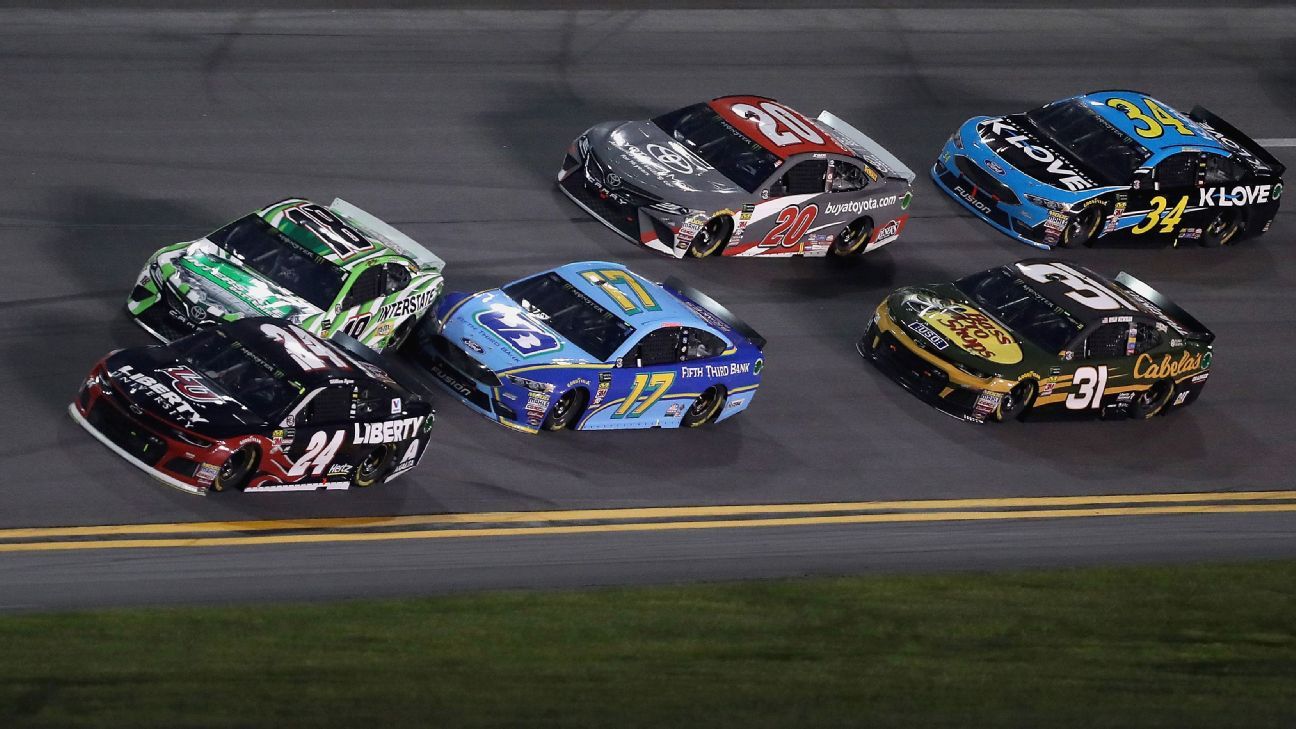NASCAR hopes that by slowing Cup Series cars and making aero adjustments to 2019, that it will have less follow-the-leader and more passing-the-leader. It also hopes fans embrace a decision to not use restrictor plates at Daytona and Talladega but only use a thicker spacer with tapered holes to restrict air flow.
NASCAR will change the current tapered spacer (a 1-inch-thick piece of aluminum that has tapered holes to restrict air flow) in Cup cars to lower horsepower from a target of 750 hp to 550 hp at 21 races — all ovals larger than 1.2 miles — next season starting after the Daytona 500.
For the 14 races that are shorter than 1.2 miles in length or are on road courses, the same spacers as this year will be used.
The 2019 Daytona 500 will run under the current Daytona/Talladega package, where a combination of a restrictor plate and tapered spacer have been used in recent years. Daytona then also will just have the spacer, as will both of the Talladega races.
Restrictor plates have been used to slow the cars down at those high-banked superspeedways since 1987.
NASCAR sent the 2019 engine and aerodynamic rules to teams Monday night to meet its Oct. 1 deadline. The hope is that by not using restrictor plates, which are much more disruptive when it comes to air flow through the engine, and combining it with new rules that increase drag and downforce, that the package will allow for more passing and potential drafting while also giving drivers the throttle response they desire.
It also is a shift from NASCAR’s recent lower-downforce philosophy, which often makes the cars more difficult to drive.
“Let me dispel the myth that NASCAR is interested in pack racing everywhere,” NASCAR executive vice president Steve O’Donnell said Tuesday afternoon. “That is not at all what this package is. This package is to take the best from the short tracks, the best from the superspeedways and meet in between.
“Do we want more cars on the lead lap? Absolutely. Do we want tighter racing? Absolutely. Do we expect three-wide every lap? No. The best drivers and the best teams are still going to win the race.”
The package is similar but has more horsepower than the 400 hp the cars had at the all-star race, as well as more downforce and more drag than in that event.
The package will include air ducts that shuffle air through the front wheel wells for 15 races (all tracks 1.2 miles in length except Daytona 500, Atlanta, Darlington, Homestead and both Pocono races), with brake ducts in those areas for the other 21 events. The spoiler will also increase for all races from 2.375 inches high to 8 inches high.
NASCAR also has created additional rules with the front splitter now 2 inches protruding from the front of the car instead of 0.25 inches and 8 inches deeper in length underneath the car, and new radiator pan specifications in order to increase front downforce. Those changes also could potentially limit areas where teams can implement new parts and pieces to help downforce.
The holes in the spacer for the 750-hp tracks will remain at 1.17 inches in diameter. The holes in the spacer for the 550-hp tracks will be 0.922 inches in diameter.
“If you look at the aero gains that have been made [by the teams causing] higher and higher corner entry speeds … where the racing line is, where the groove is, where the choice of [lane for] the driver is becomes narrower depending on how fast we’re going into the corners,” O’Donnell said.
“It’s less of a margin for Goodyear to work on to develop tires. So when we looked at that, it’s a bit of a myth that higher speeds produce better racing. That’s not the model that we looked at. The 2019 rules package is taking what we want to see to put it back in the driver’s hands.”
With the new horsepower targets, NASCAR hopes to increase the number of races an engine can be used. This year, a team had to pick 13 races where it used an engine for second event but could change cylinder heads, valves and valve springs between events. Next year, a team must do that again for 13 races but also choose three additional races where it doesn’t replace the cylinder heads and valves.
By having those engine targets, it also theoretically could encourage new manufacturers because it gives them a guideline for development. The goal for NASCAR, from an aerodynamic perspective, was to come up with a system to achieve the desired results but also keep the teams from having to build more cars specific to certain race tracks.
“When you look at that [rules] package as it stands today for longer-term development and how do we become as relevant as possible, it doesn’t match up,” O’Donnell said. “It falls into where we want to go with the next gen [of] car.
“A lot of it is going to be based on new technology in the car, and a lot of it is going to be based on efficiencies for the owners, the OEMs [manufacturers], putting an engine in place from a horsepower level that can be more relevant in the future that can attract new OEMs, which is key, and make the owners we have in the sport healthier and also attract new owners.”

